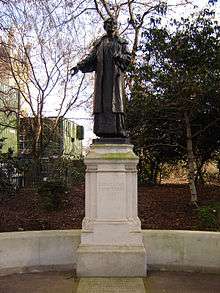Emmeline and Christabel Pankhurst Memorial

The Emmeline and Christabel Pankhurst Memorial is a memorial in London to Emmeline Pankhurst and her daughter Christabel, two of the foremost British suffragettes. It stands at the entrance to Victoria Tower Gardens, south of Victoria Tower at the southwest corner of the Palace of Westminster.[1] Its main feature is a bronze statue of Emmeline Pankhurst by Arthur George Walker, unveiled in 1930. In 1958 the statue was relocated to its current site and the bronze reliefs commemorating Christabel Pankhurst were added.
The original unveiling
Shortly after Emmeline Pankhurst's death in 1928 a Pankhurst Memorial Fund was established, with her fellow suffragettes Rosamund Massey and Katherine "Kitty" Marshall (Pankhurst's former bodyguard in the Women's Social and Political Union) as joint secretaries.[2] The fund's objectives were to arrange a headstone for her grave, to acquire Georgina Brakenbury's portrait of Pankhurst and to erect a public statue.[2] Some spectators, such as Nancy Astor, believed the idea of a statue impractical, noting that Pankhurst herself did not believe she was "statuesque" and the fact that the British public were facing austere times, which would impose financial constraints on the project.[2] In reality raising the money, which was largely organised by The Suffragette's editor Rachel Barrett, was not the issue; finding a location for the statue was the real problem.[3][4] Although the Chief Commissioner of Public Works, Sir Lionel Earle, was sympathetic to their cause, he believed that it would be impractical to place the statue in Westminster.[4] After several locations were rejected Marshall secured permission to erect the statue in a corner of Victoria Tower Gardens near the Houses of Parliament.[4] Though this required a special Parliamentary bill, the Conservative MP William Bull ensured its smooth passage.[4]
A bronze statue of Emmeline Pankhurst, with arms outstretched as if addressing a rally, was sculpted by Arthur George Walker; Sir Herbert Baker was the architect of the plinth. As well as covering the cost of the plinth and statue the fund paid the Ministry of Works £160 to have the statue cleaned in perpetuity and a further £330 to always have a plant placed in vase next to the statue.[4]
The statue was unveiled by the Prime Minister, Stanley Baldwin, on 6 March 1930.[4] Marshall had arranged for two facing platforms to be erected near the statue, one for the three speakers, Baldwin, Lady Rhondda and Fred Pethick-Lawrence, and the other for a band.[4] Loudspeakers were provided and the stages dapped in the colours of the WSPU.[4] In Baldwin's speech he said: "I say with no fear of contradiction, that whatever view posterity may take, Mrs. Pankhurst has won for herself a niche in the Temple of Fame which will last for all time."[5] The composer Ethel Smyth, a close friend of Pankhurst's, conducted the Metropolitan Police Band during the unveiling, playing an arrangement of her song "The March of the Women" and music from her opera The Wreckers. "The March of the Women" was the anthem of the women's suffrage movement.[6]
Relocation in 1958
In 1958 the statue was moved from its original position in the south of the gardens to a new site further north, and a low stone screen was built flanking the statue, terminating at either end with bronze medallions sculpted by Peter Hills. These depict, on the left, the "prison brooch" or "badge" of the WSPU,[7] and, on the right, a profile bust of Christabel Pankhurst, who died in 1958. The unveiling of this dual memorial was performed on 13 July 1959 by the Lord Chancellor, Lord Kilmuir.[8] Sylvia Pankhurst died in 1960; she is not commemorated. The statue was granted a Grade II listing in 1970.
| Components of the memorial | ||||||
|---|---|---|---|---|---|---|
|
References
- ↑ Historic England. "Statue of Mrs Emmeline Pankhurst (1357336)". National Heritage List for England. Retrieved 28 February 2015.
- 1 2 3 Pugh 2003, p. 409.
- ↑ Wallace, Ryland (2009). The Women's Suffrage Movement in Wales, 1866–1928. Cardiff: University of Wales Press. p. 291. ISBN 978-0-708-32173-7.
- 1 2 3 4 5 6 7 8 Pugh 2003, p. 410.
- ↑ Monument to a woman who changed history: Emmeline Pankhurst statue in Victoria Tower Gardens
- ↑ The Times shot some pictures of this event, one of it is in possession of Susanne Wosnitzka. At this picture Ethel Smyth is wearing her honorary doctor's robe. Some men in the background are filming this scene with cameras. A 14645, nex39621 (historicimages.com): "FAMOUS CONDUCTOR AT UNVEILING OF MRS PANKHURST STATUE. Our picture shows Dame Ethel Smythe [sic] conducting the Metropolitan Police Band when they played "The March of the Women" and the chorale from her composition "The Wreckers" at the unveiling of Mrs Pankhurst Statue".
- ↑ Holloway brooch, parliament.uk
- ↑ Ward-Jackson, Philip (2011), Public Sculpture of Historic Westminster: Volume 1, Public Sculpture of Britain, 14, Liverpool: Liverpool University Press, pp. 382–5
Bibliograph
- Pugh, Martin (2013). The Pankhursts: The History of One Radical Family. Random House. ISBN 9781448162680.
External links
-
 Media related to Emmeline Pankhurst Memorial, London at Wikimedia Commons
Media related to Emmeline Pankhurst Memorial, London at Wikimedia Commons
Coordinates: 51°29′52″N 0°07′31″W / 51.49787°N 0.12537°W


